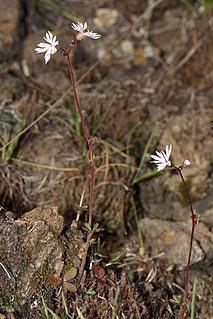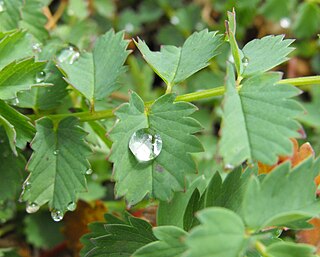
Alseuosmiaceae is a plant family of the order Asterales found in Australia, New Caledonia, and New Zealand.

Banksia aurantia, commonly known as the orange dryandra, is a shrub that is endemic to Western Australia. It has underground stems, deeply divided leaves with 18 to 28 lobes on each sides, about eighty pale orange-pink flowers in each inflorescence, and egg-shaped follicles.

Banksia bipinnatifida is a species of shrub that is endemic to Western Australia. It is a prostrate shrub with a lignotuber, an underground stem, only a few divided leaves, large cream-coloured to pale yellow flowers and large fruit.

Banksia dallanneyi, commonly known as couch honeypot, is a species of prostrate shrub that is endemic to Western Australia. It only has a short above-ground stem, pinnatipartite or pinnatisect leaves, between thirty and seventy variously coloured flowers and glabrous, egg-shaped fruit.

Blackstonia perfoliata or yellow-wort is a species of flowering plant in the family Gentianaceae found around the Mediterranean Basin, but extending into northwestern Europe.

Lepidium nitidum, known by the common name shining pepperweed, is a species of flowering plant in the mustard family.

Lepidium perfoliatum is a species of flowering plant in the mustard family known by the common names clasping pepperweed and perfoliate pepperwort. It is native to Europe and Asia and it can be found in other parts of the world as an introduced species.

Eucrypta chrysanthemifolia is a species of flowering plant in the waterleaf family known by the common name spotted hideseed.
Leptosiphon breviculus is a species of flowering plant in the phlox family known by the common name Mojave linanthus. It is endemic to California, where it is known from the Mojave Desert and dry spots in the adjacent Transverse Ranges.

Lithophragma affine is a species of flowering plant in the saxifrage family known by the common name San Francisco woodland star. It is native to the coast of western North America from Oregon to Baja California, where it grows in open habitat on mountain slopes, hills, and canyonsides. It is a rhizomatous perennial herb growing erect or leaning with a tall naked flowering stem. The leaves are located on the lower part of the stem, each divided into sharp-pointed lobes. The stem bears up to 15 widely spaced flowers, each in a cuplike calyx of red or green sepals. The five petals are bright white, up to 1.3 centimeters long, and divided into three toothlike lobes at the tips.
Lithophragma campanulatum is a species of flowering plant in the saxifrage family known by the common name Siskiyou Mountain woodland star. It is native to southern Oregon and northern California, where it grows in the forests and woods of the mountains. It is a rhizomatous perennial herb growing erect or leaning with a tall naked flowering stem. The leaves are mostly located on the lower part of the stem, each divided into rounded lobes, sometimes narrowed into teeth. The stem bears 2 to 11 flowers, each in a cuplike calyx of red or green sepals. The five petals are white, under one centimeter long, and divided into irregular toothlike lobes.

Lithophragma glabrum is a slender perennial western North American mountain plant in the Saxifrage family (Saxifragaceae), known by the common names bulbous woodland star, bulbiferous prairie-star, smooth woodland star, and smooth rockstar.

Lithophragma parviflorum is a species of flowering plant in the saxifrage family known by the common name smallflower woodland star. It is native to much of western North America from British Columbia to California to South Dakota and Nebraska, where it grows in several types of open habitat. It is a rhizomatous perennial herb growing erect or leaning with a naked flowering stem. The leaves are mainly located low on the stem, each cut into three lobes or divided into three lobed leaflets. The stem bears up to 14 flowers, each in a cuplike calyx of red or green sepals. The five petals are bright white, up to 1.6 centimeters long, and usually divided into three toothlike lobes.

Lithophragma tenellum is a species of flowering plant in the saxifrage family known by the common name slender woodland star.

Grevillea acropogon is a species of flowering plant in the family Proteaceae and is endemic to a restricted part of southwestern Western Australia. It is a prostrate to erect shrub with pinnatisect leaves with five to seven sharply-pointed lobes, and red flowers.

Reseda alba is a species of flowering plant in the reseda family known by the common names white mignonette or white upright mignonette. It is native to Europe, Asia, and North Africa, and it can be found in parts of the Americas and Australia as an introduced species. It is also cultivated as an ornamental plant for its spikelike racemes of fragrant white flowers. This is an annual or perennial herb growing up to a meter tall. The leaves are divided deeply into many narrow lobes. The inflorescence, which may take up most of the upper stem, is densely packed with many white flowers. Each flower has five or six petals, each of which is divided into three long, narrow lobes, making the raceme appear frilly. The fruit is a nearly rectangular four-angled capsule up to 1.4 centimeters in length.

Ranunculus recurvatus, the blisterwort or hooked crowfoot, is a plant species of the genus Ranunculus in the family Ranunculaceae native to eastern North America. It is an early-flowering plant of moist deciduous woods from central Quebec south to Florida.

Sanguisorba annua is a species of flowering plant in the rose family known by the common names annual burnet and prairie burnet. It is native to North America, including many areas in western and central Canada and the United States. It can be found in several types of habitat, including grassland, sagebrush, and disturbed areas. It is an annual or biennial herb producing a leafy, mostly erect stem up to about 90 centimeters in maximum height. The leaves are composed of several pairs of leaflets, each leaflet oval in shape and usually divided into lobes, sometimes deeply, the lobes becoming narrow, linear, or fingerlike. The inflorescence is a spikelike dense cluster of up to 50 flowers held erect on a tall, naked peduncle. The flower has four green sepals and no petals.

Packera breweri is a species of flowering plant in the aster family known by the common name Brewer's ragwort. It is endemic to central California, where it occurs in the woodlands and grasslands of the Central Coast Ranges. They are more frequently found in mid-southern counties of California near the coast, such as Kern or Monterey.

Sisymbrium orientale is a species of flowering plant in the family Brassicaceae known by the common names Indian hedgemustard and eastern rocket. It is native to Europe, Asia, and North Africa, and it can be found throughout much of the temperate world as an introduced species and in some areas a common roadside weed. It is an annual herb producing a hairy, branching stem up to about 30 centimeters tall. The basal leaves are divided into deep lobes or toothed leaflets. Leaves higher on the stem have lance-shaped blades with small separate lobes near the base. The top of the stem is occupied by a raceme of flowers with light yellow petals each measuring up to a centimeter long. The fruit is a silique which can be up to 10 centimeters long.


















